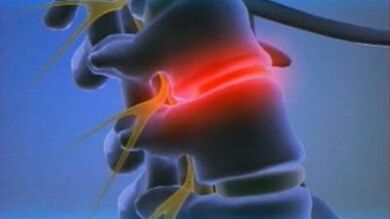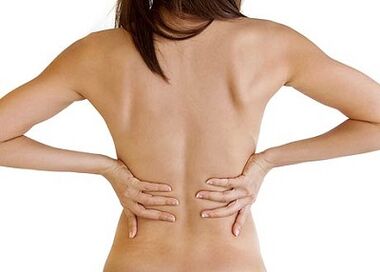Many are familiar with such a situation when pain sharply arises in the lower back due to an unsuccessful tilt or rotation of the body. But sometimes this pain is so palpable that you have to remain motionless and remain in an uncomfortable position. If you try to straighten up or just start moving, then the pain appears again. This is how osteochondrosis of the lumbar spine can begin.
What causes the occurrence of this disease? The most common cause is the disproportionate distribution of vertebral loads. Here's a simple example:
A significant proportion of people lead a predominantly sedentary lifestyle. As a result, some muscles are completely inactive, while others, on the contrary, are constantly in a state of tension. That is, it turns out that muscle tone is not distributed correctly. This, in turn, leads to the fact that specific areas of the spine are experiencing much more stress than necessary.

Our spine is designed in such a way that it can withstand colossal loads for a certain time. But this ability is manifested, as a rule, in isolated cases. When the overload is constant, the intervertebral discs experience considerable pressure and, ultimately, begin to protrude between the vertebrae (that is, hernias are formed). In addition, damage to the intervertebral discs leads to compression of the spinal nerves, resulting in the so-called radicular syndrome. Finally, the diseased area of the back becomes limited in mobility, the person experiences pain and discomfort.
Symptoms of the disease
The most common symptom of lumbar osteochondrosis is a dull aching pain localized in the lower back. In some cases, such pain radiates to the legs.
In addition, patients complain of pain in the legs that they experience while lifting heavy weights, as well as when coughing or sneezing, when changing body positions, especially after a long stay in one position.
An exacerbation of osteochondrosis is accompanied by symptoms such as the inability to perform unnecessary movement and overstrain of the spinal muscles. When exposed to cold, so-called lumbago may appear, that is, acute pain in the lower back.
Other signs of the disease include:
- the appearance of goose bumps and tingling feet;
- failure of sensitivity in the thighs, legs and buttocks. In rare cases - also in the foot;
- arterial cramps in the feet (up to the disappearance of the pulse), chilliness of the legs;
- violation of sweating;
- the occurrence of dry skin and its peeling in places of pain localization. Loss of sensitivity is possible.

Other signs are typical for those cases when osteochondrosis is associated with pinching of the spinal cord:
- Failure to urinate and defecate;
- Incorrect sensitivity of the genitals or bladder.
Finally, it is necessary to note additional symptoms arising from the instability of the vertebrae:
- in men, a violation of potency acts as a sign;
- in women - problems with the ovaries, uterus and appendages.
Lumbar osteochondrosis treatment
Treatment of the disease in question is aimed at:
- elimination of those factors that affect the spinal nerves;
- restoration of full-fledged physical activity;
- elimination of all emerging pathological changes.
All these tasks are solved at each stage of the treatment of osteochondrosis, as a result of which the common goal is achieved - the complete recovery of the patient.
There are 4 stages of treatment, each of which we will consider.
The first stage is the provision of medical care aimed at eliminating the pain symptom. Such assistance is provided in any medical institution, and can also be provided independently. We are talking about taking anesthetic cocktails, applying compresses and rubbing.

At the second stage, symptomatic treatment is already underway, during which analgesic blockades are applied and vasodilating drugs are injected, for example, baralgin or a solution of nicotinic acid. Dehydrating drugs are also used.
Surgical methods of treatment can also be applied here. These include:
- decompression of constricted vessels, nerves;
- removal of a hernia;
- elimination of scars, adhesions and bone growths - everything that causes pain;
- the use of prosthetics of intervertebral discs;
- ensuring fixation of the affected vertebrae.
The length of the rehabilitation period depends on what kind of surgical intervention will be used. Today, low-traumatic laser interventions are widespread, when a micro-incision is performed using laser technology. In such cases, rehabilitation takes only a few days.
The third stage is treatment by a neurologist. At this stage, the specific form and stage of osteochondrosis is determined, long-acting hormones are introduced, and appropriate therapy is prescribed. And immediately after this stage, they move on to the next, fourth, within which the lost functions are restored.
Physical exercises
It is therapeutic gymnastics that determines the content of the fourth stage in the treatment of osteochondrosis. In general, exercise is the most effective method of eliminating the disturbances that have arisen. Of course, achieving a positive result is possible only if you regularly perform the appropriate set of exercises. As an example, we will give one of the possible complexes:
Exercise 1
Starting position: lie on a flat and firm surface (on your back) and place your hands on the sides of your body.
Action: Arch your back and try to stretch your spine as much as possible.
Quantity: repeat the exercise at least 5-6 times.

Exercise 2
Starting position: similar to the previous exercise.
Actions: stretch your arms up and begin to stretch smoothly. Try not to strain your back.
Quantity: 3-4 repetitions are enough.
Exercise # 3
Starting position: lie on your stomach and lower your arms at your sides.
Action: round your back, at the same time tighten your shoulders. Stretch the spine in this way.
Quantity: It is best to do the exercise at least 5 times.
Exercise 4
Starting position: similar to the previous exercise.
Actions: make smooth turns with the lower part of the body (first to the left, then to the right). At the same time, strive to keep your back flat on the floor.
Amount: the best option is 3-4 repetitions.
Thus, in the course of the treatment of lumbar osteochondrosis, it is important to identify all the signs of the disease, carefully examine them and ensure the appropriate effect, including through the performance of gymnastic exercises.
















































